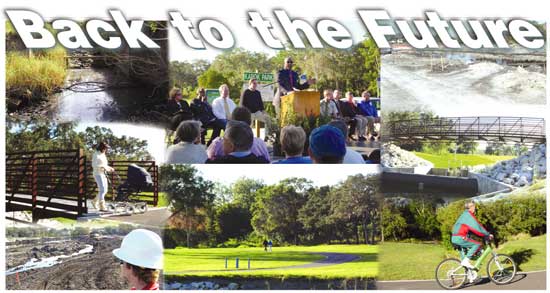
Clearwater Mayor Frank Hibbard calls it “another gem in the crown of Clearwater,” but Kapok Park wasn’t always a beautiful public green space, home to roseate spoonbills, wood storks, sandpipers and many other shorebirds.
In December, Representative Gus Bilirakis joined members of the District’s Governing and Pinellas-Anclote River Basin boards, along with the Clearwater mayor and several city staff members, in celebrating the completion of a $19.3 million floodplain restoration project.
The Kapok Wetland and Floodplain Restoration Project transformed the former site of the Friendly Village of Kapok mobile home park back into a 37-acre floodplain with 26 acres of wetland habitat.
“This project offers floodplain, natural systems and water quality benefits, as well as recreational opportunities,” said Paul Miselis, District project manager.
According to historic aerial photography, the area was once a portion of the Alligator Creek floodplain and supported a hardwood swamp ecosystem before developers started to fill in the floodplain and channelized the stream in the 1960s.
In 1997, the area was identified in the Alligator Creek Watershed Management Plan as the most widely recognized and publicized flooding problem within the Alligator Creek watershed due to its severity, frequency and the number of affected residences.
The watershed management plan, which was funded by the District, Clearwater, Pinellas County and Safety Harbor, identified causes and sources of flooding, water quality degradation and habitat loss within the 5,691-acre area. It also identified projects that would improve these conditions.
The plan investigated several alternatives to alleviate the flooding in the mobile home park. Storing water upstream in a flood detention area and further channeling Alligator Creek were determined to be infeasible from an engineering and environmental permitting standpoint.
Purchasing the mobile home park and going forward with the restoration project was determined to be the best option. The project involved removing an upstream control weir, building a new weir structure at the downstream reach of Alligator Creek on the Kapok property and restoring the property to its predevelopment condition. The City of Clearwater purchased the land for approximately $10 million, which includes $3.5 million provided by Florida Community Trust toward the purchase of the property. Other costs the city covered include relocating the residents and demolishing or removing the mobile homes.
“This project exemplifies the power of partnerships between government entities,” said Todd Pressman, Governing Board member and co-chair of the Pinellas-Anclote River Basin Board.
The District provided $3.5 million in funding for design and construction. This funding was divided among the District’s Pinellas-Anclote River Basin Board ($1.4 million) and the state Surface Water Improvement and Management (SWIM) Program ($2.1 million.)
The Florida Department of Environmental Protection also provided $400,000 for construction.
The District’s SWIM Program, which includes projects like the Kapok wetland restoration project, benefits from the Tampa Bay Restoration Bill. The bill, which was sponsored in the House by Representative Gus Bilirakis, provides additional state funding for projects that improve the health of Tampa Bay. Last year the District’s SWIM Program received $1.25 million from this bill.
“When I was chair, we had the opportunity to seek funding from the state for restoration projects that impact Tampa Bay,” said Watson Haynes II, Governing Board member and co−chair of the Pinellas−Anclote River Basin Board. “Representative Bilirakis was always there for the District.”
With the site restored to its original purpose, the area will be able to sustain its floodplain function. The park also serves as an extension to the Clearwater east−west trail and park system.
